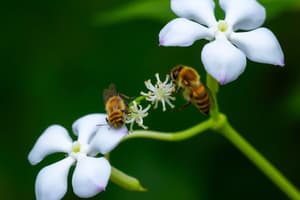Podcast
Questions and Answers
What is the primary function of petals in flowering plants?
What is the primary function of petals in flowering plants?
- To attract pollinators (correct)
- To protect the flower bud
- To produce sperm cells
- To form the seed coat
What occurs during the fertilization process in flowering plants?
What occurs during the fertilization process in flowering plants?
- The stigma absorbs nutrients
- Pollen from different plants is exchanged
- The pollen tube delivers sperm to the ovule (correct)
- The ovary protects the embryo from the external environment
Which type of pollination involves pollen transfer within the same flower?
Which type of pollination involves pollen transfer within the same flower?
- Natural pollination
- Self-pollination (correct)
- Cross-pollination
- Artificial pollination
Which part of the flower is involved in forming the female gametophyte?
Which part of the flower is involved in forming the female gametophyte?
What is the role of the endosperm in seed development?
What is the role of the endosperm in seed development?
What is the outcome of the genetic variation promoted by sexual reproduction in flowering plants?
What is the outcome of the genetic variation promoted by sexual reproduction in flowering plants?
Which environmental factor is likely to influence the timing of flowering in plants?
Which environmental factor is likely to influence the timing of flowering in plants?
What type of fruit is characterized by a fleshy texture, such as apples and berries?
What type of fruit is characterized by a fleshy texture, such as apples and berries?
Study Notes
Overview of Sexual Reproduction in Flowering Plants
- Definition: Process where male and female gametes unite to form a zygote, leading to seed and fruit development.
Key Structures
-
Flower: Reproductive organ, composed of:
- Petals: Attract pollinators.
- Sepals: Protect the flower bud.
- Stamens: Male reproductive part (anther + filament).
- Pistil: Female reproductive part (stigma + style + ovary).
-
Gametophytes:
- Male Gametophyte: Pollen grain (produces sperm).
- Female Gametophyte: Embryo sac (contains egg cell).
Process of Sexual Reproduction
-
Pollination:
- Transfer of pollen from anther to stigma.
- Types:
- Self-pollination: Pollen from the same flower/plant.
- Cross-pollination: Pollen from different flowers/plants.
-
Fertilization:
- Pollen tube grows down the style to the ovule.
- Sperm cells travel through the pollen tube; one fertilizes the egg to form a zygote, and another fuses with two polar nuclei to form endosperm (triploid tissue that nourishes the developing embryo).
-
Seed Development:
- Ovule develops into a seed.
- Seed consists of:
- Embryo: Develops into the new plant.
- Endosperm: Nutrient supply for the embryo.
- Seed coat: Protective covering.
-
Fruit Formation:
- Ovary matures into fruit, aiding in seed dispersal.
- Types of fruits:
- Fleshy: (e.g., apples, berries).
- Dry: (e.g., nuts, pods).
Importance of Sexual Reproduction
- Genetic Variation: Promotes diversity, enabling adaptation to environmental changes.
- Evolutionary Advantages: Enhances survival and propagation of species.
Factors Affecting Sexual Reproduction
- Environmental Conditions: Temperature, light, and water availability influence flowering and reproduction.
- Pollinator Activity: Availability and behavior of pollinators can affect pollination success.
Summary
- Sexual reproduction in flowering plants involves the production of male and female gametes, pollination, fertilization, seed development, and fruit formation, ultimately contributing to genetic diversity and species survival.
Overview of Sexual Reproduction in Flowering Plants
- Sexual reproduction unites male and female gametes, resulting in zygote formation and subsequent seed and fruit development.
Key Structures
-
Flower: The main reproductive organ, with key components including:
- Petals: Brightly colored structures that attract pollinators.
- Sepals: Leaf-like parts that protect the flower bud.
- Stamens: Male reproductive part, consisting of the anther (where pollen is produced) and the filament (supports the anther).
- Pistil: Female reproductive part, composed of stigma (receives pollen), style (connects stigma to ovary), and ovary (contains ovules).
-
Gametophytes:
- Male Gametophyte: Pollen grain that produces sperm cells.
- Female Gametophyte: Embryo sac which houses the egg cell.
Process of Sexual Reproduction
-
Pollination:
- Involves transferring pollen from the anther to the stigma.
- Types of pollination:
- Self-pollination: Occurs within the same flower or plant.
- Cross-pollination: Occurs between different flowers or plants.
-
Fertilization:
- Pollen tube extends down the style to the ovule.
- Sperm cells travel through the pollen tube:
- One sperm fertilizes the egg to create a zygote.
- Another sperm cell fuses with two polar nuclei forming endosperm, a triploid tissue that nourishes the embryo.
-
Seed Development:
- The ovule matures into a seed, consisting of:
- Embryo: Develops into a new plant.
- Endosperm: Provides nutrients for the embryo.
- Seed coat: Protects the seed.
- The ovule matures into a seed, consisting of:
-
Fruit Formation:
- The ovary matures into fruit, which aids in seed dispersal.
- Types of fruits include:
- Fleshy fruits: Examples are apples and berries.
- Dry fruits: Examples are nuts and pods.
Importance of Sexual Reproduction
- Promotes genetic variation, allowing plants to adapt to changing environments.
- Provides evolutionary advantages, enhancing the survival and propagation of species.
Factors Affecting Sexual Reproduction
- Environmental Conditions: Factors like temperature, light, and water availability can impact flowering and reproduction.
- Pollinator Activity: The presence and behavior of pollinators influence the success of pollination.
Summary
- The sexual reproduction cycle in flowering plants encompasses the formation of gametes, pollination, fertilization, seed development, and fruit creation, ultimately fostering genetic diversity and enhancing species survival.
Studying That Suits You
Use AI to generate personalized quizzes and flashcards to suit your learning preferences.
Description
This quiz covers the key concepts of sexual reproduction in flowering plants, detailing the various structures involved such as flowers, gametophytes, and the processes of pollination and fertilization. Test your knowledge on the reproductive strategies and structures that facilitate the development of seeds and fruits.




